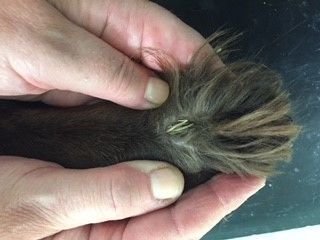
Beware the dreaded grass seed
Grass Seed Season is upon us...
So as much as we enjoy watching our dogs frolicking around in the long grass, it often comes with a price - the dreaded grass seed.
On our group walks we do find it difficult to avoid long grassy areas, and though I give all dogs a quick check during and after each walk for loose seeds, it’s important that you try to double check your dogs all over every day - especially the eyes, ears and paws - for any lingering grass seeds. Grass seeds can affect any breed of dog, but it’s even more important to check longer haired breeds such as spaniels and cockapoos etc, as they are harder to spot without a thorough check.
As well as checking your dog physically, keep an eye out for unusual scratching, licking, head shaking, or rubbing specific areas of the body, as these can all be signs of an embedded grass seed. Bowie once suffered a grass seed stuck in his eye. Initially presenting as a watery eye which he couldn’t open, the seed had travelled so far up into the eye socket that it had to be removed under sedation. Though I had a few hours of sleepy Bowie peace afterwards, if left untreated, grass seeds in the eye can damage the cornea and even lead to blindness.
It has been suggested that a bread and milk poultice could help to try and draw out a seed in the paw in the very early stages, however I would suggest only doing this if regular access to your vets is limited and you’ve no other option. Because grass seeds are barbed (arrow shaped), once they become embedded in the skin, it’s very difficult to draw them out again. If left untreated, embedded grass seeds can cause serious infections, as well as being quite uncomfortable for your pooch.
Emergency vet visits as a result of grass seeds are one of the most common yet painful things our dogs can suffer, so it’s worth giving your dog a quick check over every night to try and avoid any hefty vet bills and poorly pooches!
